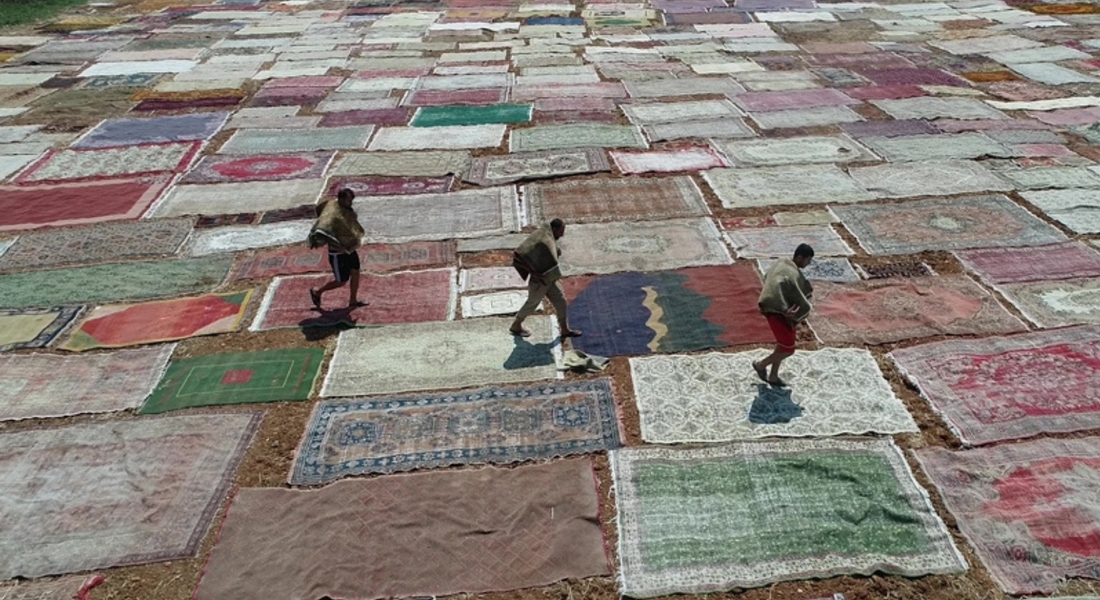It's been many years since people started appreciating vintage style and worn-in look instead of new and untouched look. And what's not to love?
When carefully picked, retro details, such as a vintage rug, in your living space will add a certain warmth and homey feel. If you were looking for a perfect item to complement your furnishings, a beautiful vintage rug might be just the right fit.

A vintage rug is a timeless piece of art that will brighten up your room and be a conversation-starter. But there are some things you need to know before you make a final decision about adding an authentic vintage carpet to your living space.
We have prepared a guide for you to learn about different types of vintage rugs and choose the right one for your home.
What Is A Vintage Rug?

As far as the styles are concerned, vintage rugs come in many different ones. The most popular vintage rugs on market today are overdyed, distressed, or patchwork rugs.
What Makes a Rug Vintage?
When it comes to rugs, the term vintage describes rugs that are between 30 and 80 years old. Some websites even say that we can apply this term to all the carpets that are between 25 and 100 years old.
Any rug older than 100 falls into the antique category.
Origins of Vintage Rugs

Traditionally, rugs can be identified by the place of origin. For example, there are vintage rugs from Morocco, the Middle East, Central Asia, India, Tibet, Turkey, Iran, Pakistan, Sweden, etc.
When searching through different styles, if you can't remember the correct terms, just try to note the area they were produced in.
An authentic vintage rug is hand-knotted and made from wool on a wool foundation or wool on a cotton foundation. It has no backing and shows an integrated fringe.

Every vintage style rug has its history, creation process, and appeal. To make an educated choice, we are going to talk about each style in more detail.
Three Types of Vintage Rugs
Distressed Rugs

Distressed rugs are hand-woven vintage Turkish rugs that are still in good condition, considering their age.
Artisans collect and carefully wash them to remove stains and dirt. Then they shear the rugs and sometimes leave them in the sun to fade the colors naturally.
This process breathes a new life into the old carpets, and they become highly desirable distressed rugs.
Overdyed Rugs

Despite their gorgeously exotic look, vintage rug designs don't always sit well with contemporary aesthetics. In such cases, overdyed rugs make a better fit.
One company in Turkey came up with the idea of taking rugs with out-of-style colors and patterns and overdying them to achieve a more modern look. Overdyed rugs still have the vintage charm, but new, vibrant colors make them look revived.
Artisans create overdyed rugs by taking old rugs and neutralizing them with a special solution. This solution cleans the wool but preserves the weft and the original design. Then the carpets are overdyed with a new color.
Patchwork Rugs

Artisans make patchwork rugs by sewing together pieces of multiple rugs using sturdy yarn. The patched pieces are then additionally reinforced with a cotton backing.
Artisans who create these rugs combine contrasting colors or various shades of the same tone. Each piece can also have a different pattern. That's why every patchwork rug is a truly unique work of art.
If you opt for these incredible patchwork rugs, there are a couple of options we can suggest:
-
Overdyed patchwork rugs

This type of rug is meticulously handcrafted from pieces of many different overdyed rugs. Whether you opt for a mono-colored or multicolored overdyed patchwork rug, you will get a carpet that's both shabby and chic.
-
Kilim patchwork rugs

For a more rustic look, we suggest kilim patchwork rugs. Their unusual look and feel come from the fact that artisans create them using a combination of goat hair and cotton. This exciting mixture of materials, along with a strong cotton backing, makes kilim rugs highly durable.
How to Style Vintage Rugs

We believe that vintage rugs, with their unique beauty, can complement any home decor. The best approach is to look at it as a piece of art.
If your room is already bursting with colors, your vintage rug should be in a color that sets off the tones of the furnishings. On the other hand, placing a colorful carpet in a minimalist space will make a room look centered and lively.

Another exciting trend is to put a rug on another rug. This layering trick will make your home look sophisticated and stylish. If you decide to try it out, though, be mindful of the color palette and the texture of the rugs.
For example, a bold-colored carpet over a neutral one is a perfect combination. Overdyed vintage rugs look excellent in a layered setting.
The Benefits of Handcrafted Rugs

Although machine-made carpets are often more affordable, it's easy to spot a winner when comparing vintage rugs to handcrafted ones.
Handcrafting takes a lot of time, but in turn, produces a high-quality, durable rug. The proof is that even after 50 years, we are still using such rugs all over the world.
Furthermore, each hand-made rug is one-of-a-kind. Weaver puts their creativity, dreams, and thoughts into their work. Therefore, what you buy is unique and priceless.
The Importance of Eco-Friendly Rugs

In the age of over-pollution and too many single-use items, the idea of turning something old and undesirable into a highly sought-after product is priceless.
As we've previously mentioned, most authentic vintage rugs were out-of-style carpets hiding in the back of the store or lying in the attic until talented craftsmen and craftswomen revived their original beauty.
Distressed rugs, overdyed rugs, and patchwork rugs were all dead inventory at one point.

Authentic vintage rugs are made of natural materials such as wool, cotton, or silk. Therefore, you can be sure they are eco-friendly and won't add to the pollution.
In addition, vintage rugs are sustainable (they've already been around for 50 years and still look incredible), and you can place them in different settings or move them around the house as your creativity dictates.

Every authentic, hand-made vintage rug is a good investment. Not only will it bring gorgeous patterns and an explosion of colors to your home, but you will be able to enjoy them in the years to come.
You can reuse vintage rugs and make sure they stay with your family for generations.
How To Recognize A Vintage Rug
Since vintage rugs became so popular, it might be helpful to note a couple of tips on separating them from machine-made ones.
-
Look at the knots

Authentic vintage rugs are hand-made, which means that, upon closer inspection, you'll notice that the knots are uneven. On the contrary, machine-made rugs have consistent knotting throughout the entire rug.
-
Look at the fringe

Handcrafted carpets have a fringe that is an extension of the knot-work. On the other hand, machine-made rugs have a sewn-on fringe.
-
Look at the backside

When you flip over a genuine vintage rug, there is a pattern that matches the top side. If you notice that latex is covering the backside, it means that the rug is machine-made from synthetic materials, and the latex covering is holding the weave in place.
-
Look at the material

As already mentioned, hand-woven carpets are made of wool, making them long-lasting, and have a distinctive, high-quality feel. On the other hand, machine-made rugs are usually made of synthetic materials such as polypropylene, nylon, acrylic, or polyester. These materials are cheap and last a short time.
If you'd like to learn more, we suggest reading our guide on how to tell if a rug is handmade.
Why Choose a Vintage Rug

If you are still wondering whether to opt for an authentic vintage rug or a cheaper machine-made one, you must understand the importance of a hand-made item. Not only will you be investing in beautiful artwork, but you also get a high-quality product that will stay with your family for decades to come.
Choose vintage rugs for your home; they're not only durable, but also beautiful, sustainable, valuable, and affordable. By placing this trendy piece of decor in your room, you will create a stylish and inviting atmosphere.

